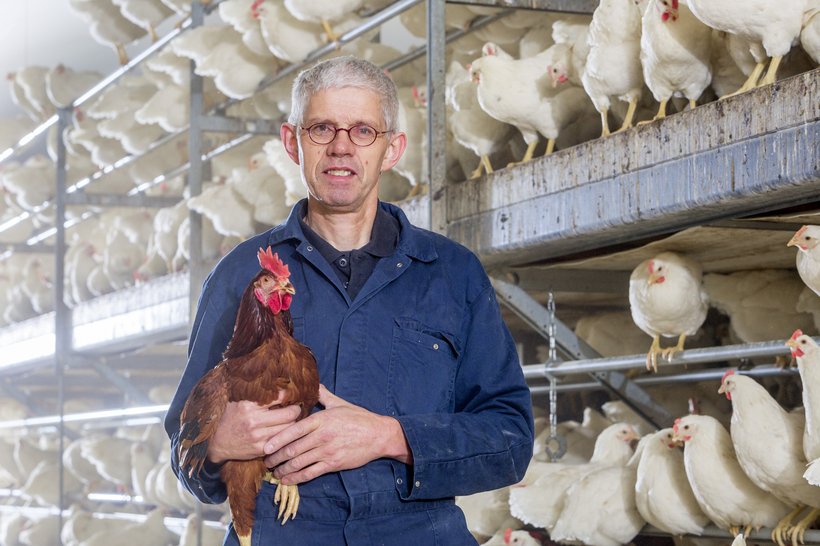
Published on Sept. 20, 2019
The challenge of designing a vaccination program for layers
Extended laying cycles has become a reality worldwide and an unstoppable trend. Selective breeding for persistency has certainly played a major role in achieving increased performances, but besides genetics, we should not forget the other key factors for success in egg production, like improved management practices, better suited nutrition, high biosecurity standards and adapted “tailor made” vaccination programs.
In the egg industry, the primary objective of vaccination programs is to minimize the adverse effect of disease on health, welfare and performances of layer flocks, but also decrease the public health risk by increasing birds’ resistance to zoonoses (i.e. Salmonella enteritidis).
In this context of longer production cycles, duration of immunity is a hot topic and a major concern for egg producers. In addition to “traditional” live and inactivated vaccines, new alternatives like vector vaccines are increasingly available. A major advantage of these recombinant vaccines is long life protection, through recirculation of the vector (HVT and pox). Further research and development is expected from vaccine-producing companies.
Vaccination in the hatchery
In previous years, most of the day old chicks were only vaccinated against Marek disease in the hatchery. Development of automatic equipment for hatcheries now make it easier to ensure a reliable and consistent vaccination. Reduction of labor costs, lowered risk of poorly conducted farm vaccination, and availability of new vaccines (recombinant, immune complex…) are some of the reasons behind an increasing demand for hatchery vaccination.
A wide range of vaccines can be administered today in the hatchery, either by injection (generally subcutaneous, less frequently intramuscular) or spray, more rarely by eye drop: Marek disease and HVT vector-based vaccines, infectious bronchitis, Newcastle disease, coccidiosis etc.
There are definitely some benefits for the poultry producers, as aforementioned, when they receive their chicks already vaccinated at day old, but there are also some limiting factors:
- Compatibility between vaccines: for instance, recombinant HVT vector-based vaccines are not compatible with conventional HVT Marek vaccines or other vaccines using the turkey herpes virus as a vector.
- Recombinant vaccines are not spreading, so it is extremely important that all the chicks are vaccinated, none should be missed or as few as possible.
- Day old chicks go through some stress the day of hatch: they are taken off, sexed, beak-treated, vaccinated… and they still have to travel, likely for many hours, until they arrive at the farm. Vaccination program should not be too intensive, they are just 35 to 45 g little creatures! The proper decision on what vaccines to administer in the hatchery should be based on each rearing farm situation and disease challenge, which will determine priorities for early protection.
Vaccination during rearing
Ideally, the vaccination program should be completed within the 17 weeks of the rearing period. It would completely unrealistic to recommend a single program valid for all regions, farms and conditions, as it should be adapted to each unique situation. However, there are some basic common principles:
Depending on the disease pressure, life of a rearing pullet is too short to give all available vaccinations, and in some regions it is not uncommon to find extremely intensive vaccination programs, with as many as one vaccination every 7 days. Frequently half of these interventions require individual handling of the pullets, because route of administration is injection or eye drop. A proper balance should be found between the benefit of protecting the flock and the possible adverse effect on growth and uniformity of these overburdened programs.
- Live vaccines are usually effective when mass applied, used for priming and boosting, stimulate local immunity and generally induce a rapid onset of immunity of short duration.
- Inactivated vaccines are almost always injected, can be used as boosters to stimulate a slower but long-lasting immunity and higher antibody levels.
- Recombinant vaccines for use in the farm are pox vector-based, applied by wing web and can be used for combined protection against fowl pox and other diseases (ILT, Newcastle…).
A frequently forgotten aspect is the metabolic cost of immunity: when vaccines are used, energy and amino acids are required for an adequate immune response, either local or humoral (synthesizing antibodies). This means that the pullets have to use part of their nutritional resources for immune defense activation.
An additional problem is respecting the recommended intervals between vaccinations: for instance, it is a general recommendation to allow two weeks between different live respiratory vaccinations. Sometimes, in areas where Newcastle disease is a major concern and programs are overfilled with vaccines against this disease, it is not easy to protect the flock properly against Infectious Bronchitis since both vaccine virus can interfere.
Vaccination during the production period
Depending on the disease challenge, vaccines can also be used during the production period, more frequently against Newcastle disease and infectious bronchitis by spray or drinking water route, but some programs even include inactivated vaccines for these diseases or others (avian influenza).
In the field, we often see very heavy vaccination programs in lay since there is a trend to add extra vaccines in endemic areas for any of these respiratory diseases where many flocks are hit. If a reasonable interval is not respected, the result is not always a better protection, as the immune system is too often requested to react, but a higher risk of suboptimal performances, linked to post-vaccination reactions and/or limited energy resources used for immune response instead of production.
A particularly risky practice is vaccinating layers between 18 weeks and peak of lay: feed intake capacity is still limited during this period and might not cover the high nutritional requirements for production and growth. Additional stress during those critical weeks can compromise further laying performances.
